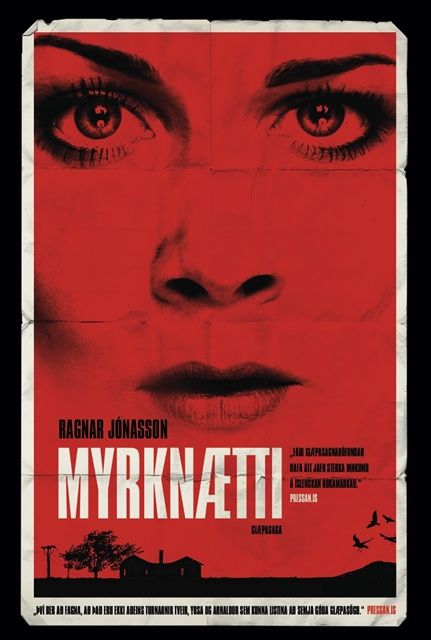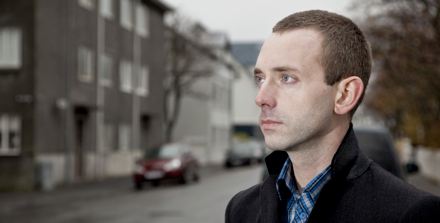Dark Night
“Even the brightest of days can turn out to be dark and gloomy once you look beneath the surface,” says crime author Ragnar Jónasson of his third novel, Dark Night.
 “Even the brightest of days can turn out to be dark and gloomy once you look beneath the surface,” says crime author Ragnar Jónasson of his third novel, Dark Night (orig. Myrknætti), the translation rights of which were recently sold to German publishing house Fischer Verlag. Fischer previously published Ragnar's debut novel, Snowblind (published in German as Schneebraut), to considerable acclaim, during Iceland's year as Guest of Honour at the Frankfurt Book Fair.
“Even the brightest of days can turn out to be dark and gloomy once you look beneath the surface,” says crime author Ragnar Jónasson of his third novel, Dark Night (orig. Myrknætti), the translation rights of which were recently sold to German publishing house Fischer Verlag. Fischer previously published Ragnar's debut novel, Snowblind (published in German as Schneebraut), to considerable acclaim, during Iceland's year as Guest of Honour at the Frankfurt Book Fair.
As behooves a crime novel, Dark Night opens with the discovery of a body – in Northern Iceland, not far from the fishing town Siglufjörður. Small-town cop Ari Þór, known from Ragnar's previous novels, is again put on the case, while trying to get his personal affairs in order. It appears that the deceased, a contractor, was far from an innocent soul, and the murder case causes other crimes to surface. The murder and its backstory come to the attention of the media, and a young female reporter from Reykjavik, Ísrún, travels up north to look into the matter – but she has some secrets of her own. Meanwhile, the life of a young Nepalese woman, lured to Iceland under false pretense, hangs by a thread.
In Dark Night, Ragnar writes about the imperfections of human nature. “It's about issues such as human trafficking, bullying and child abuse, and the focal point is the investigation of a brutal murder committed during a bright summer night.”
The title is in direct contrast with the book's setting, which takes place during the brightest days of Icelandic summer, when it is light for over 20 hours at a time.
“You could say that crime novels are often about a sort of sleight of hand – convincing the reader that day is night, before the truth is revealed. I tried to define these opposites even more clearly by setting the action during a memorable summer day in 2010, when a thick cloud of volcanic ash drifted across Reykjavík, blocking out the sun.”
 What were your main objectives with writing Dark Night, being an independent sequel to your debut, Snowblind?
What were your main objectives with writing Dark Night, being an independent sequel to your debut, Snowblind?
“I wanted Dark Night to be able to stand on its own, even though it shares the protagonist Ari Þór with the older novel. This time around, I added another hero, the reporter Ísrún. I was a reporter myself during my college years. It's a very exciting business, and I wanted to write about it. I also thought it was important that the environment of the new story differed from that of Snowblind, where the town is buried beneath a thick coat of snow, and so I picked a time of year when it's bright virtually around the clock.”
You weren't afraid that Siglufjörður's small size and remoteness would constrain the narrative too much?
“Yes, I do keep in mind that a small town like Siglufjörður can't harbour that many crimes, even fictional ones. The town played a large role in Snowblind, but I'm careful to set the action of Dark Night in a more varied milieu. My grandfather and namesake, Þ. Ragnar Jónasson, wrote much on the history of Siglufjörður, and I wanted to write, in my own way, about this unique place. I envision Snowblind and Dark Night as the first two installments of a trilogy starring my old home town. After that, I'll refrain from unleashing any more crime on the townspeople of Siglufjörður.”
Far from idle these days, Ragnar is far into the final book of the series. “As in Dark Night, the actual crime isn't committed in Siglufjörður, although much of the story takes place there. Ari and Ísrún are again the protagonists, and although they deal with separate cases, their paths intertwine. Ari has to work under some very strange circumstances, which I probably shouldn't say much about, and has the chance to look into a fifty-year-old case – the mysterious death of a young woman in Northern Iceland. Ísrún, on the other hand, is drawn into two investigations, one of which deals with a murder, and the other a young family that receives sinister threats from an apparent stranger.”
Ragnar will attend the crime fiction conference Crimefest in Bristol this month, participating in a panel discussion of Nordic crime fiction, along with three Scandinavian authors. “I won't be the only Icelander present,” he says. “Yrsa Sigurðardóttir will also participate in discussions at the event, as she has done for the past few years. By my count, the conference guests are about four hundred this year, including such masters of the genre as P. D. James, Lee Child and Frederick Forsyth.
Finally, what do you think has propelled Nordic crime fiction to its recent international popularity?
“When reading crime fiction, I am primarily fascinated by three things: a memorable setting, strong characters and a good plot. I think this is probably the key to the success of Nordic crime novels. They usually place great emphasis on a fascinating and often exotic setting, and characters are drawn very clearly, often by making them mirror pressing and disputed social issues. And the plot, of course, plays a central part in all crime novels. It has to be interesting and believable, and it often includes a surprise for the reader at the end.”
Interview: Davíð K. Gestsson
Translation: Steingrímur Teague
Photo of Author: Ómar Óskarsson
